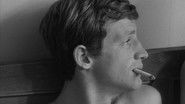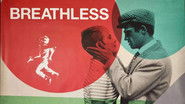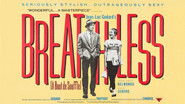GodeonWay
Much of the time, if you profess to not like Breathless, a few New Wave devotees kind of sniff and intimate that, obviously, you didn't understand it.The hell I didn't. I was a teenager when the New Wave (Godard, Truffaut, Chabrol, Resnais, et. al) erupted. I saw ALL the key films when they came out. I tried very hard to be impressed, to string along with the huge number of critics who oohed with delight about cinema verité, hand-held cameras and improvised dialogue. But I couldn't do it then, and I still can't.I've watched Breathless twice completely and half a dozen times incompletely, over the past 50+ years. Yes, I understand it's a milestone. Yes, the film was a radical departure from standard studio-produced fare. Yes, it broke many so-called 'rules' of feature film-making.But sorry. All that doesn't make for a movie that's good. It bores. It rambles. It irritates by its ineptness. The images are very uneven in quality. The sound is pretty bad. In truth, one is expected, even urged, to admire it for its defects.Jean-Luc Godard (who is Swiss, though considered one of the pillars of the French New Wave) still makes movies today in 2018, at 87 years of age. Still does the festival circuit. And his movies are much improved technically. Almost all have a few pretty good scenes. But by and large, they're not meant to entertain. They're supposed to make you think. To react and reflect on the images and ideas he's throwing out at you.Now, back to Breathless (which a poor translation of the original French title 'A bout de souffle' that really means 'out of steam, out of energy, near the end of the line'.)If you've never seen it, by all means do so, simply for its reputation. And if like me, you were lucky enough to visit Paris in the 1950s and early 1960s, you'll be rewarded by once again seeing the city as it really was. Complete with a girl (the late, beloved Jean Seberg) on foot, hawking the late, beloved International Herald Tribune to American tourists. Just for those delights, my rating is 4/10 - about two points higher than it might otherwise receive from soft-hearted me.PS: If you find New Wave really hard to get through, stick with Truffaut. He rarely bores the way Godard and Resnais do. And how he evolved, year by year, into a master film craftsman is a story in itself.
reasonablyniceperson
Besides the fact that you will save $100,000 another reason to skip Film School is that you won't be required to sit through a screening of "Breathless" - a class that should be titled "How to Make a Self-Indulgent Home Movie Posing As Art" that examines what is essentially an exercise in cinematic masturbation.Okay, Godard did things differently. He not only ignored The Rules of filmmaking; he thumbed his nose at them. This may be enough to endear him to immature film students because of the rebellious nature of youth. This sentiment is usually reinforced when they learn that he is a life-long Communist, which is like, so cool! (No traditional bourgeois filmmaking principles like "Telling a Story" for Godard. How liberating!) Unfortunately, it is also the folly of youth to believe that New & Different is somehow synonymous with Innovative & Better - a notion has clouded the judgement of many seemingly rational people old enough to know better when it comes to their assessment of what constitutes Art. Watching early works of Godard like "À Bout de Soufflé" and "Pierrot le Fou" reminds me of a child exclaiming, Mommy, Daddy - look at me! Look at what I'm doing." Nonetheless there are actually two good reasons why you should bite the bullet (or take a stiff drink) and watch "Breathless." The first is the very 50s-ish jazzy score by Martial Solal, which totally fits the film and captures the atmosphere in the disjointed and somewhat crazy scenario (such as it is.) The second reason is the incomparable Jean Seberg. You will become captivated by her as soon as she appears on the screen, but then you will fall hopelessly in love with this utterly charming gamin Américaine when you see her slowly walking on the Champs-Elysees calling out, "New York Herald Tribune" with newspapers that she is trying to sell bundled in her arm.Godard famously said, "All that you need to make a good film is a girl and a gun." At least he was half right.
Ore-Sama
Some films are simply famous without necessarily being influential, or at least not widely so. Then there are films that are not merely well known, but a significant advancement that alters cinema forever. Some of these films are artifacts that are really only worthwhile as a piece of history. Examples of this would include something like "Voyage to the Moon", which meant a lot to film history, but as a film, is so primitive as to be laughable. Then there are those works that function both as great films and significant steps in cinema. A number of silent films fall under this category, such as "Metropolis", "Cabinet of Dr Caligari", and "Nosferatu". "Breathless" falls into the later category, not only being one of the most influential films ever made, but also a truly great film.The plot, thin as it is, revolves around Michel (who takes on the look and mannerisms of Humphry Boggart) who is chased down by a cop he ends up shooting. The police are after him. We see a few scenes of the police questioning people and hunting him down, but it's not the focus of the film. Michel instead steals some money, gets together with a woman named Patricia, trying to sleep with her, then run away from her, and get the money he's owed.Much in the way Godard broke and played with the rules of cinema, so Michel makes his own rules, dictating his own pace. He knows the police are after him, and he does try to avoid them, yet he refuses to be inconvenienced. He does whatever he feels like doing at the time. Make no mistake, Michel is far from a saint. Yet it is this determination to do what means the most to him, however random it seems, or however shallow it seems, that gives "Breathless" real humanity beneath the detached way the characters act. We're watching someone who, knowing his demise could come at any moment, will make as much as he can of the time he has. Knowing that, nothing he does in this film is meaningless. Even the tiniest of things, such as him stopping to admire the humphry boggart poster, means so much more.Make no mistake, though, there's plenty else to admire about the film. The cinematography is fantastic. Using a hand-held camera and a wheelchair instead of a dolly for moving shots, we have a movie that rarely feels still. The camera is often intimately close, using only a few far away shots (often simply to establish distance between characters). The jump cuts this film is famous for are used stylistically. Even when indoors,it feels like things are in constant motion, ensuring that the film never feels slow, and even after all these years, the visual style of the film feels unique unto itself, even among the rest of Godard's filmography.Something also must be said of the dialogue. It's fast, it's snappy, topics change constantly, characters contradict themselves, make references, etc. It's certainly stylized dialogue, delivered so naturally, but this dialogue gives the film sheer entertainment value. There's just something about watching the conversations unfold that is hypnotic, almost a thing of poetry. The apartment scene in particular I rate as one of the greatest scenes in cinema.As a piece of history, "Breathless" is equally fascinating. While an argument could be made about what the best french new wave film is (there's certainly steep competition in that department, "The 400 Blows" and "Pickpocket" as two examples), "Breathless" is the defining one. The film, more than any other, that gave a sense of freedom to film makers everywhere, showing they didn't have to limit themselves to a rigid narrative structure. The jump cuts also, of course, were a huge innovation and have been used to the point of almost tedium throughout cinema ever since. There's certainly more to say on the historical side, but I don't want this to get too long.The casual viewer will likely have a tough time with this one. Unlike relatively straightforward french new wave like the before mentioned "400 Blows", "Breathless" is abstract and likely to leave the unprepared viewer bored, confused and dismissive. I warn you do not go into this movie expecting a thriller, or a film that is in anyway conventional. This is a film where characters waste time,conversations go nowhere and last a long time, and the plot is the least relevant thing occurring for 95% of the movie.I know, that sounds awful, and in the hands of someone else, "Breathless" would be a worthless train wreck of a movie on par with the works of Uli Lommel. Yet in the hands of "Godard", it is a mesmerizing film experience.
seymourblack-1
Jean-Luc Godard is one of the French New Wave directors who, as critics in the 1950s, had been regular contributors to the influential publication "Cahiers Du Cinema". As a group, they were disenchanted with the output of the French film industry at that time and believed that by putting the director at the centre of the creative process and dispensing with traditional narrative conventions, a far more imaginative style of filmmaking could be achieved. In his first film, Godard sought to achieve this by a variety of means which included, borrowing from some earlier cinematic styles that he admired.In "Breathless" ("A Bout De Soufflé"), a simple film noir plot is presented in a style that owes much to the influence of the Italian Neo-Realists (e.g. filming on location, use of hand-held cameras and improvised dialogue). Additionally, by using unorthodox techniques such as "jump cuts" and getting characters to look directly into the camera and then injecting the action with great pace, the result is a movie that looks vibrant, spontaneous and highly energetic.At the time of its release, few could have imagined the impact that "Breathless" would have on filmmaking in general or the profound influence it would subsequently have on numerous directors such as John Cassavetes, Martin Scorsese and Quentin Tarantino.Michel Poiccard (Jean-Paul Belmondo) is a small-time criminal who after stealing a car in Marseilles and killing a motorcycle cop, makes his way to Paris to collect some money that he's owed and reunite with one of his girlfriends called Patricia Franchini (Jean Seberg). Patricia's an American student who has aspirations to become a journalist and earns some money by selling the "New York Herald-Tribune" on the Champs Elysees. Michel wants to escape to Italy as soon as he can collect his money and wants Patricia to go with him but she tells him that she can't leave Paris for financial reasons.Michel spends his time in Paris sharing Patricia's hotel room and the couple talk a great deal about life and love whilst Michel also tries relentlessly to seduce her. Despite the seriousness of his crimes, Michel seems very unconcerned about the situation he's in and if he does feel desperate, certainly hides it well beneath a façade of being super-cool. He's totally amoral and an inveterate thief but is also very preoccupied with trying to emulate the mannerisms of his hero, Humphrey Bogart.Patricia is a cold character who's fascinated by Michel's lifestyle but always remains emotionally detached even when they seem to be at their closest. Things get increasingly complicated for Michel as the police manhunt intensifies but eventually matters are brought to a head by a simple action that's incredibly casual, uncaring and self-serving.French New Wave directors Francois Truffaut, Claude Chabrol and Jean-Pierre Melville all contributed in different ways to the making of this movie and Alain Resnais' "Hiroshima Mon Amour" (1959) is just one of a whole collection of other films and filmmakers that are referenced. Amusingly, Michel's alias in the movie is Laszlo Kovacs and he also uses some of Humphrey Bogart's photos outside a cinema that's showing "The Harder They Fall" (1956) to perfect his attempt to look and act as much like Bogey as possible.In retrospect, it's no exaggeration to describe "Breathless" as a masterpiece because its exhilarating combination of originality, freshness and sheer enthusiasm was genuinely revolutionary when it was made and it became an incredibly rich source of inspiration to other filmmakers in the years that followed.










